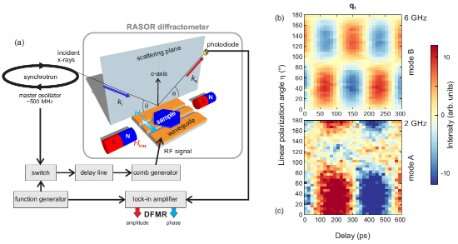Picosecond magnetization dynamics of spin modes revealed by diffractive ferromagnetic resonance

As nanoelectronics encounters fundamental barriers, the spin of an electron, in addition to its charge, is being utilized to carry information in electronic devices. This calls for new characterization and detection methods of spin modes in complex magnetic structures. Present techniques measure either material properties on the nanometer length scale or on the picosecond time scale, however, both are needed simultaneously to obtain a complete picture in order to advance future technological developments.
Researchers from Diamond Light Source's Magnetic Spectroscopy Group, the University of Oxford, and ShanghaiTech University have developed a novel diffractive ferromagnetic resonance (DFMR) technique for retrieving the dynamics of individual spin modes. DFMR combines the power of two measurement techniques, resonant elastic X-ray scattering (REXS) for retrieving the detailed spin structure of a magnetic system, and X-ray detected ferromagnetic resonance (XFMR) for accessing the element-selective magnetization dynamics. The team's recent publication in Nano Letters demonstrates their DFMR technique by studying the spin dynamics of a multiferroic hexaferrite, which has great potential for information storage applications.
Experimental studies of magnetization dynamics
The study of magnetization dynamics is crucial for the development of new magnetic storage materials and devices, which are typically composed of several different layers. The most widely used technique, ferromagnetic resonance (FMR), gives insight into only the integrated magnetization dynamics within these complex systems. This is where synchrotron radiation offers a solution. Making use of the X-ray magnetic circular dichroism (XMCD) effect, magnetic and chemical contrast is obtained, which allows for studying the element-specific magnetization dynamics in X-ray detected FMR.
The diffractive FMR technique
The DFMR technique is a union of REXS—which reveals the static magnetic structure in reciprocal space—and XFMR, which is used to reveal the time dependence of this structure. The research team carried out their measurements in the RASOR diffractometer on Diamond's I10 beamline, which provides both variable sample temperatures and magnetic fields. The incident X-rays are tuned to the L2,3 absorption edge of the 3d transition-metal element of interest, and the magnetic diffraction condition can typically be met for spin modulations from 10s to 100s nm. The magnetization dynamics is sampled stroboscopically, making use of the X-ray pulse structure of the synchrotron of 500 MHz (the master oscillator clock of the Diamond storage ring) and synchronization with a microwave field applied to the sample. A delay line allows for phase shifting of the microwave oscillation with respect to the X-ray pulses. This way, the magnetic signal can be monitored as a function of the delay between microwave excitation (pump) and X-ray bunch arrival (probe). DFMR combines REXS and XFMR by measuring the change in intensity of the scattered peaks resulting from the stroboscopic probing of the magnetic structure. A schematic of the experimental setup is shown in Figure 1 together with measured DFMR delay scans of the magnetic peaks as a function of linear polarization angle.
Next steps
Innovative magnetic materials have played, and will continue to play, a pivotal role for the increase in data storage capacity for years to come. Their continuing development, and especially due the advent of complex, topologically ordered magnetic systems, requires suitable ultra-sensitive characterization tools in their native GHz frequency domain. With DFMR, the team has established a key tool that will aid researchers in their quest to synthesize and engineer new skyrmion and multiferroic materials in which ordered magnetic moments can be manipulated via the application of electric or magnetic fields, with the goal to develop high-density and low-energy consumption data processing solutions.
Lead author Dr. David Burn explains:
"We believe that the development of diffractive FMR presents a major breakthrough for spintronics as it allows, for the first time, the study of dynamic magnetization modes down to the nanoscale with spatial, temporal and chemical resolution. This length scale, in combination with 10 GHz dynamic range, is crucial for the development of post-CMOS magnetic logic and memory devices. We are certain that it will have a significant impact on the wider scientific community."
More information: David M. Burn et al. Mode-Resolved Detection of Magnetization Dynamics Using X-ray Diffractive Ferromagnetic Resonance, Nano Letters (2019). DOI: 10.1021/acs.nanolett.9b03989
Journal information: Nano Letters
Provided by Diamond Light Source





















